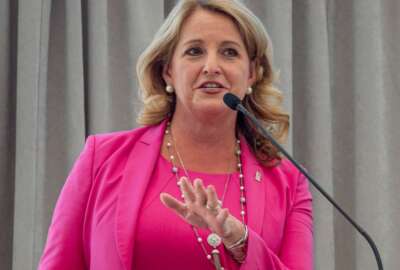

OMB says it's not worried about agencies' ability to pay back Technology Modernization Fund project loans as proposals were considered based on their ability to...
This story is part of an exclusive look inside the projects funded by the Technology Modernization Fund. To see the other stories in this series, use the main navigation page.
The Technology Modernization Fund is an innovative tool to enable IT modernization across the federal government. The TMF has funded projects to modernize legacy systems, expedite the adoption of commercial capabilities, and support the development and use of shared services across federal agencies. An example is the Labor Department’s Labor Certificate Processing Modernization project that highlights the impact that the TMF is making. This project digitizes a paper-based visa labor certification process with a modern and efficient “e-certification.” The modernization project also creates a shared data hub that improves inter-agency collaboration and communications. The combined focus on both the data and digital strategy delivers significant operational improved in the quality, consistency, and availability of the mission centric data for Labor and their partner federal agencies.

TMF funded projects make quarterly updates to the board. Additionally, the TMF Program Management Office often communicates more frequently with the agency project team. The most significant trend from these quarterly reviews is the importance of business and technology leaders working together to solve modernization challenges.
Federal projects funded by the TMF are paying back loans according to their approved project plans. When an agency repays TMF funds, those funds are then returned to the TMF program to be made available for reinvestment in future modernization efforts as approved by the board. The TMF Board continues to review and approve projects for investment. The latest project allocates $15 million to Customs and Border Protection (CBP) to modernize the agency’s 30-year-old collection tool, the Automated Commercial System. This system is CBP’s last remaining mainframe system and runs on 3.9 million lines of COBOL code. The modernization not only improves the long-term supportability of the system but also gives CBP the ability to better meet its mission.
No — each project proposal is considered, in part, based on its ability to repay the loan. As part of the proposal process, federal agencies also commit to repaying the loan. The Board and the TMF Program Management Office frequently communicate with each approved project team which helps identify any potential future issues. If agencies find they need to adjust the repayment amounts or schedule, they are able to request approval through the Board. In addition, administrative mechanisms are in place that would enable the TMF to recover any awarded funds an agency was not able to repay.
As a requirement for an agency to be awarded TMF funds, each project is required to produce a “playbook” at the conclusion on their modernization effort. The playbook also encompasses a variety of perspectives and lessons learned from the modernization project. Knowledge is also shared through the TMF Project Management Office team consulting with agencies preparing to make a new proposal to the Board, through other TMF Board members who are themselves federal chief information officers, and through forums such as the CIO Council.
Federal agencies have submitted over 50 project proposals, totaling more than $550 million, to the TMF Board. The board has approved 10 of those proposals. Each project proposal represents a transformative modernization effort that has unique technical, financial, and mission-focused objectives for the Board to consider. The TMF Board evaluates each unique project proposal using the open, transparent, and fair process shared online at tmf.cio.gov.
Copyright © 2024 Federal News Network. All rights reserved. This website is not intended for users located within the European Economic Area.
Jason Miller is executive editor of Federal News Network and directs news coverage on the people, policy and programs of the federal government.
Follow @jmillerWFED



